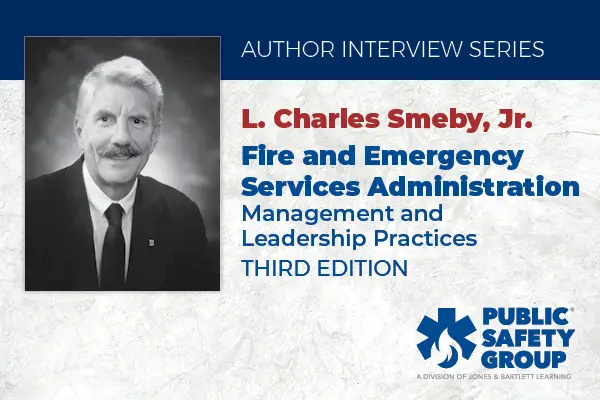An Interview with Fire Author L. Charles Smeby, Jr.

As part of the Jones & Bartlett Learning Public Safety Group Author Interview series, we had the chance to talk with Chuck Smeby about the all-new Third Edition of his book, Fire and Emergency Services Administration: Management and Leadership Practices, to learn more about his experience, what’s new in the book, and why he thinks it’s a valuable contribution to the fire service community.
Check out the interview below and a video of Chuck Smeby discussing the Third Edition here:
Can you tell us about your background in the fire service?
There have been three parts to my Fire Service career. First, I was the Battalion Chief for Prince George’s County Fire Department, which covers 500 square miles of both urban and rural regions in Maryland. The department was in charge of fire and EMS services for the whole county, which gave me substantial experience with engines, truck companies, and rescue squads, including command at large scale emergencies. I also served in the Fire Prevention Bureau and, finally, became the first Safety Officer for the department. Second, I served at the National Fire Protection Association, where I worked in the Public Protection Division to help create and update fire service codes and standards, as well helping people to understand them. Finally, I serve as a faculty member at University of Florida, where I was hired to start their distance learning program for Bachelors’ in Fire and Emergency Services Administration, which continues to provide higher education opportunities to students today. In terms of education, I have a Bachelors’ in Fire Protection Engineering, as well as a Masters in Public Policy from the University of Maryland.
Why did you want to write Fire and Emergency Services Administration: Management and Leadership Practices, Third Edition?
Between my experience in the fire service and my time as a college instructor, I have extensive notes and lectures that I felt could help give a comprehensive education to fire and emergency service professional administrators. I also look at it as a way to pass on my knowledge and many others on how administrators should interact and manage their team, the public, and elected officials.
What’s new in the Third Edition that you think will interest readers, both instructors and students alike?
The book has been updated on all the latest legal issues and techniques in supervision and leading since the Second Edition. Numerous updates to terminology have been made throughout the book as well. I’ve also tried to clarify confusing language and simplify it a bit for easier reading and understanding by the students.
One extensive update includes critical information about the COVID-19 vaccine and its impact on fire and EMS operations.
Which chapter in the book do you think is the strongest and will leave the biggest impact on readers?
Chapter 4 “Leadership” covers the deceptively confusing subject of leadership for a lot of administrators and members. Any time change occurs in an organization, it can be traumatic for a lot of members since many just hate change. Others worry that change will conflict with their personal goals, whether it be personally or at an organizational level. For this chapter, I’ve included a 7-step process for being successful at implementing progressive changes that can be difficult for members to accept.
Why is ethics such an important topic and skill for fire service personnel to learn about (and apply) in their job functions?
There was a time where ethics wasn’t really taught in many professions, whether it be firefighters, engineers, doctors, and others. Once the need became clear, college classes began teaching people how to make ethical and moral decisions. Ethics is vital to the well-being of our profession; firefighters need to be taught to think twice before doing something that might be viewed as immoral. It can often be hard to step back and take an objective look at our own actions. Many fire administrators have lost their jobs because they did something unethical that they thought was ethical, but their boss and the public didn’t see it that way. If we want to keep the trust of the public, proper ethics must be emphasized constantly throughout education and training. This is especially important for the Fire Chief to survive in his/her highly political position.
Can you elaborate on the differences between management and leadership principles?
Administrators need two skills: management and leadership. Management refers to making sure goals have been set and that your department has the tools and trained personnel needed to meet those goals. Leadership involves being comfortable leading your team through difficult situations that require making progressive and possibly controversial changes in the organization. All administrators need a process and the knowledge to identify, implement, and lead their team into changes, since many people are uneasy with the thought of change.
What do you hope readers will take away from your book once they’re finished with it?
I hope they’ll find it applicable for members at all levels of fire and emergency service (FES) organizations. Many chief administrators, supervisors and members see changes they’d like to make, but they just don’t feel comfortable making them for fear of backlash. The focus of this book, besides explaining the history and organization of FES, is on being able to make progressive change, especially safety policies which can be painful and hard, but not impossible with the right kind of plan.
For more information on Fire and Emergency Services Administration: Management and Leadership Practices, Third Edition, please visit our website or contact your Public Safety Group representative today.